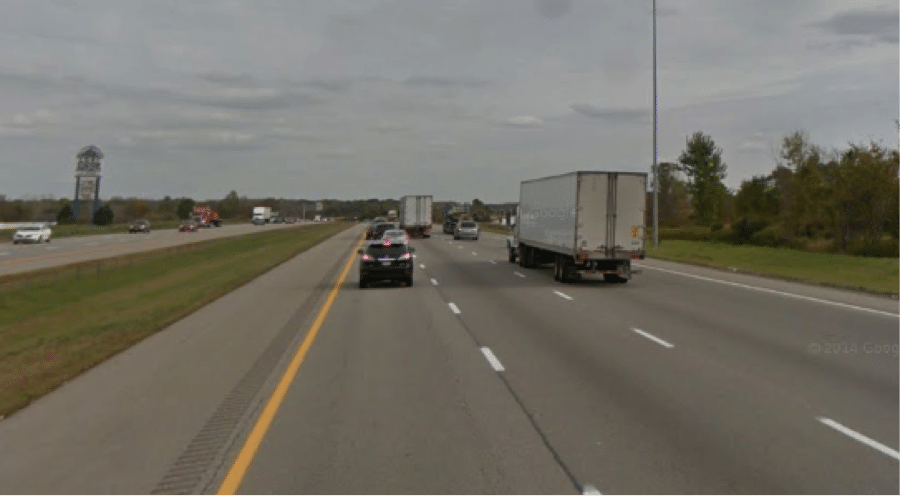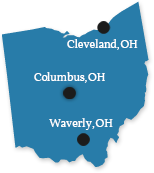As Ohioans, we’re used to seeing cars and trucks from neighboring states on our roads. For decades, we have been a state of transport, proudly allowing – literally — the wheels of commerce to pass through on our highways. But these highways, loaded with 80,000-pound tractor-trailers, are also what the rest of us rely on to move our families from place to place.
Unfortunately, these trucks, paired with our harsh winter climate and out-of-state drivers often unfamiliar with our road system, frequently lead to severe car accidents. In 2013, an average of 274 people were injured every day in accidents on Ohio roads and highways. Nearly 1,000 people lost their lives in an accident.
Here at Plevin & Gallucci, we thought you might be interested to know how our car accident attorneys view a particular stretch of highway, and how we take precautions to avoid being in an accident ourselves. As we frequently drive between our offices in Cleveland and Columbus, we have complied a list of accident-prone areas that many drivers pass through on this route. The next time you drive this way, you may want to pay extra attention to the road.
Starting in Cleveland & Inner Belt Freeways
It’s common for urban freeways to be fast-paced and full of merging drivers rushing to get to their destinations. The most important thing you can do: Give them a little room. Statistics show that the closer cars are to one another, the more likely they are to be in an accident. Makes sense.
If part of your trip takes you on the Inner Belt freeway on I-90, be careful not to linger in the slow lane or a lane used for merging. Doing so will only ensure you get cut off or forced into an unsafe situation. This area in downtown Cleveland will be under construction until late 2016, so be extra alert for construction vehicles and unexpected changes in traffic patterns and lanes, especially at I-90 and I-490,
Hot Spot: Watch out for the 25th Street exit near Starkweather Avenue, as many drivers are coming up and off side streets and I-490.
As you continue on I-71, Pearl, Fulton, 130th and 150th Avenues are also congested. Since you’re on I-71 for the next few hours, definitely try to avoid merging lanes and obey the speed limit. This gives you adequate room on both sides of the car to maneuver and avoid dangers as well.
One of the most dangerous driving areas in Cleveland is where I-71 intersects with I-480 near the airport. There is always heavy traffic in this area and drivers leaving I-71 to merge onto I-480 have to move quickly across multiple lanes to get on the highway. Be prepared for slow traffic here and be especially watchful for drivers darting across the lanes of the highway.
Once you pass the airport, the drive opens up. As you cruise, always be mindful of merging traffic and erratic drivers.
I-71 & I-76 Merge Near Chippewa Lake and Medina:
This stretch area of freeway brings us close to Medina, where the speed limit increases to 65 mph and later to 70 mph. It’s fairly safe and open, with the exception of some bridges that tend to be abrupt when you cross them. The occasional slow-merging truck and not-too-frequent freeway driver are ones to watch.
U.S. 83, Wooster
Just outside of Burbank, you come upon Lodi Station Outlets at the exit for U.S. 83, Wooster, a congested area frequented by trucks.
Pro: Outlet stores, restaurants, and restrooms!
Con: This is a major truck stop area with a Pilot fuel center just across the street. Use caution when crossing the street or merging, and allow plenty of room for truckers trying to merge and return to highway speed.

Ashland and Mansfield on Down to Sunbury
Accidents often occur in and around the passing lanes. Watch for the merge and transition on Route 36, and especially keep an eye out for truckers and big rigs at night. Remember that they require a greater distance to stop, especially in wet or icy conditions. Trucks often weight more than 15x as much as a standard car, so there is no “small” accident with a truck.

(Image caption: With a guardrail and trees on one side, and a tractor-trailer on the other, we literally have to “share” the road.)
Fortunately, the state of Ohio has now widened I-71 to three lanes in both directions from Cleveland to Columbus, so traffic flows more smoothly than in the past. But with the extra lane in each direction and the higher speed limit between Medina and Columbus, speeding is very common here.
Westerville and Surrounding Columbus (Go Buckeyes!)
After passing Polaris Parkway, often a very congested exit due to a high volume of drivers heading to Polaris Fashion Place Mall and its surrounding restaurants, hotels, and offices, you have entered Westerville, and should see the lights of downtown Columbus just in the distance. Be careful approaching the Outerbelt, I-270, as locals rushing into town may approach at higher speeds. Again, this is a time to be aware of your lane choice to be sure you have plenty room to change lanes or avoid unexpected debris in the road.
On Saturdays in the fall when the Ohio State University Buckeyes are playing a football game at home, be prepared for extremely heavy traffic on all highways approaching Columbus and all exits and streets leading to the University, beginning early in the morning and through the evening. Traffic often comes to a complete standstill; frequent starts and stops and lane jockeying can make for dangerous driving.
Another high traffic area is the Easton Way exit of I-270 near Easton Town Center. This is a common area for accidents.
Once you pass I-670, you are definitely in the inner loop. This again presents the same kind of challenges as the Inner Belt in downtown Cleveland: people jockeying for position to get on the highway and get to where they are going.
But, If You Are Heading Northbound…
If you head back this same route, remember that heading northbound there is a frontage road at the I-670 merge, and it’s poorly organized. In fact, where I-71 northbound merges near I-670 is one of the most dangerous areas for car and truck accidents in the state. Proceed with caution at all times, in all conditions.
Remember: in congested areas, the most dangerous thing you can do is drive aggressively or follow too closely. This leaves little room for error, whether the error is made by you or by another driver.
When driving, if you see names like Freightliner, Mack and Kenworth, remember that 18-wheelers can legally weigh up to 80,000 pounds without a special permit in Ohio. A big rig this size weighs as much as 13 Ford F-150 full-size trucks. The inertia and momentum these trucks carry with them are dangerous and should always be kept top of mind.
Let’s Help Other Ohioans!
We are working to collect more feedback on dangerous roads, interchanges, and intersections in Ohio. These will be compiled on our website and made available to help everyone in Ohio understand how to keep their family safer when driving on our highways and avoid traffic accidents.
If you have a suggestion, please comment below! Your help is greatly appreciated!

